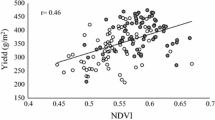Abstract
Recent studies have demonstrated an association between increased stomatal conductance and genetic improvement of yield potential of wheat. However, the sensitivity of stomata to changes in environmental conditions makes screening of large populations for leaf conductance difficult in a breeding program. A rapid and inexpensive viscous air-flow porometer has recently been developed to accurately measure leaf conductance in amphistomatous species. This porometer has potential to assist in the rapid screening of cereal populations aimed at identifying families with high leaf conductance and potentially high yield potential. In this study, random F2:4, BC2F2:4, and BC2F5:7 progeny from crosses between low and high stomatal conductance wheat varieties were assessed for leaf conductance using the viscous air-flow porometer in two field environments. Significant (p< 0.05) genotypic variation was observed for leaf conductance in both the F2:4 and BC2F2:4 populations, and there was some evidence for transgressive segregation towards higher conductance in the BC2F2:4 population. Phenotypic distributions for leaf conductance among progeny were approximately normal suggesting quantitative inheritance, while heritability on a family-mean basis ranged between 26 and 73% indicating potential for genetic gain from selection for leaf conductance. A relatively greater leaf-to-leaf sampling variance highlighted the need for measurements on more leaves per plot in order to increase the precision of comparisons among family means, especially in early generations. Increasing the number of leaves sampled in each plot should pose little problem for plant breeders because successive leaves can be measured rapidly (ca. five leaves/minute) with the viscous air-flow porometer.
Similar content being viewed by others
References
Carver, B.F., R.C. Johnson & A.L. Rayburn, 1989. Genetic analysis of photosynthetic variationin hexaploid and tetraploid wheat and their interspecific hybrids. Photo Res 20: 105–118.
Clarke, J.M., 1997.Inheritance of stomatal conductance in a durum wheat cross. Can J Pl Sci 77: 623–625.
Clarke, J.M. & F.R. Clarke, 1996. Considerations in design and analysis of experiments to measure stomatal conductance of wheat. Crop Sci 36: 1401–1405.
Condon, A.G., G.D. Farquhar & R.A. Richards, 1990. Genotypic variation incarbon isotope discrimination and transpiration efficiency in wheat. Aust J Pl Physiol 17: 9–22.
Falconer, D.S. & T.F.C. Mackay, 1996. Introduction to Quantitative Genetics, 4th edn. Longman Group Ltd, Essex, UK.
Fischer, R.A., D. Rees, K.D. Sayre, Z. Lu, A.G. Condon & A.L. Saavendra, 1998. Wheat yield progress isassociated with higher stomatal conductance, higher photosynthetic rate and cooler canopies. Crop Sci 38: 1467–1475.
Gay, A.P., 1994. Breeding for leaf water conductance, its heritability and its effect on water use in Lolium perenn.Aspects of Applied Biology - Efficiency of Water Use in Crop Systems 38: 41–46.
Hallauer, A.R. & J.B. Miranda, 1981. Quantitative Genetics in Maize Breeding, 2nd ed. Iowa St. Uni. Press, Ames, IA.
Hanson, W.D., 1963. Heritability. In: W.D. Hanson & H.F. Robinson (Eds.), Statistical Genetics and PlantBreeding, pp. 124–140, National Academy Science, New York.
Jones, H.G., 1987. Breeding for stomatalcharacters. In: E. Zeiger, G.D. Farquhar & I.R. Cowan (Eds.), Stomatal Function, pp. 431–443, Stanford University Press, Stanford.
Littell, R.C., G.A. Milliken, W.W. Stroup & R.D. Wolfinger, 1996. SAS System forMixed models. SAS Institute Inc., Cary, NC.
Lu, Z., R.G. Pearcy, C.O. Qualset & E. Zeiger, 1998. Stomatalconductance predicts yields in irrigated Pima cotton and bread wheat grown at high temperatures. J Exp Bot 49: 453–460.
McDermitt, D.K., 1990. Sources of error in the estimation of stomatal conductance and transpiration from porometerdata. Hort Sci 25: 1538–1548.
Morgan, J.A. & D.R. LeCain, 1991. Leaf gas exchange and related leaftraits among 15 winter wheat genotypes. Crop Sci 31: 443–448.
Morrison, M.J., H.D. Voldeng & E.R. Cober,1999. Physiological changes from 58 years of genetic improvement of short-season soybean cultivars in Canada. Agron J 91: 685–659.
Nyquist, W.E., 1991. Estimation of heritability and prediction of selection response in plantpopulations. Crit Rev Pl Sci 10: 235–322.
Percy, R.G., Z.M. Lu, J.W. Radin, E.L. Turcotte & E. Zeiger,1996. Inheritance of stomatal conductance in cotton (Gossypium barbadense). Phys Plant 96: 389–394.
Quail, K.J., R.A. Fischer & J.T. Wood, 1989. Early generation selection in wheat. I. Yield potential. Aust J AgricRes 40: 1117–1133.
Rawson, H.M., R.M. Gifford & P.M. Bremner, 1976. Carbon dioxide exchange inrelation to sink demand in wheat. Planta 132: 19–32.
Rawson, H.M. & B. Hulse, 1996. An inexpensivepocket-sized instrument for rapid ranking of wheat genotypes for leaf resistance. In: R.A. Richards et al. (Eds.), Proc. 8th Ass. Wheat Breed. Soc. Australia, pp. P127–P129, CSIRO Plant Industry, Canberra.
Rebetzke, G.J., J.J. Read, M.M. Barbour, A.G. Condon & H.M. Rawson, 2000. A hand-held porometer for rapid assessment of leaf conductance in wheat. Crop Sci 40: 277–280.
Reynolds, M.P., M. Balota, M.I.B. Delgado, I. Amani & R.A. Fischer,1994. Physiological and morphological traits associated with spring wheat yield under hot, irrigated conditions. Aust J Pl Phys 21: 717–730.
Richards, R.A., 1991. Crop improvement for temperate Australia: future opportunities.Field Crops Res 26: 1141–1169.
Zadoks, J.C., T.T. Chang & C.F. Konzak, 1974. A decimal code forthe growth stages of cereals. Weed Res 14: 415–421.
Author information
Authors and Affiliations
Rights and permissions
About this article
Cite this article
Rebetzke, G., Condon, A., Richards, R. et al. Phenotypic variation and sampling for leaf conductance in wheat (Triticum aestivum L.) breeding populations. Euphytica 121, 335–341 (2001). https://doi.org/10.1023/A:1012035720423
Issue Date:
DOI: https://doi.org/10.1023/A:1012035720423




